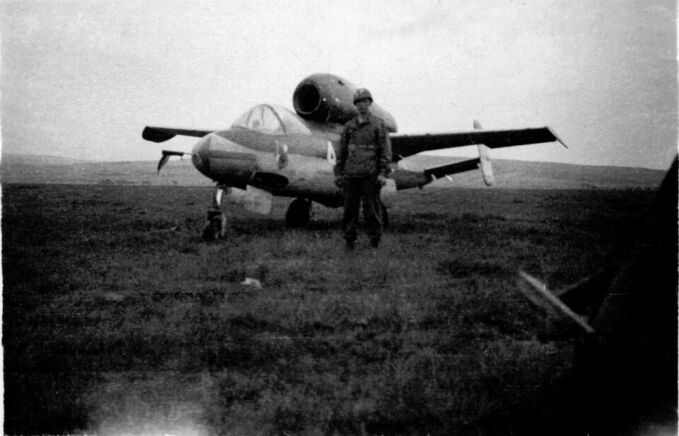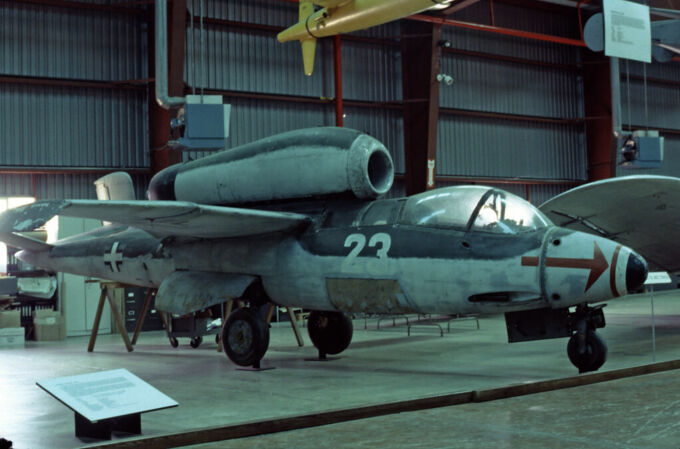The Heinkel He 162 Volksjäger was Nazi Germany’s desperate last-ditch attempt to field a cheap, easily produced jet fighter in the closing months of World War II. Designed in a matter of weeks, it was meant to be the savior of the crumbling Luftwaffe, a mass-produced miracle piloted by barely trained teenagers. Instead, it became a symbol of the Reich’s technological ambition outstripped by harsh reality, a war machine built in frantic haste as Germany spiraled into defeat.
Desperate Origins
By 1944, Germany’s war effort was collapsing. The Allies had seized air superiority, their bombers raining destruction upon the Reich’s cities and war industries. The Luftwaffe was hemorrhaging aircraft and pilots faster than it could replace them. Nazi leadership, desperate to regain control of the skies, demanded a jet fighter that could be built cheaply, rapidly, and without the need for scarce resources such as aluminum. Thus, the Volksjäger (“People’s Fighter”) project was born.
The idea was audacious—an aircraft so simple that it could be assembled primarily from wood and flown by the Hitler Youth with minimal training. Heinkel, already versed in jet technology with the He 178 and He 280, won the contract by promising a fully operational aircraft in just three months as part of the Emergency Fighter Program. Engineers worked feverishly, sacrificing safety for speed. The result was the He 162— the aircraft featured a sleek fuselage with a top-mounted BMW 003 turbojet engine, an inverted V-tail, and wooden wings. The codename for its wing-construction program was "Salamander", and with its green and white counter-shaded camouflage, it certainly looked the part.
The Salamander Takes Flight
The first prototype of the He 162 took flight on December 6, 1944, a remarkable achievement given the compressed development timeline. However, the flight ended in an emergency landing when the nose gear strut door failed, attributed to the use of substandard adhesives and rushed construction processes. Despite this setback, the program pressed on, implementing design modifications to address the structural issues.
The second flight resulted in disaster, with the glue causing structural failure in one wing, followed by the plane breaking apart in the air and killing the test pilot. This, however, did not set production back by a single day. Engineers scrambled to strengthen the aircraft, reinforcing weak components while Heinkel’s assembly lines would soon churn out finished units.
The People's Fighter
After the war, Ernst Heinkel said, "The unrealistic notion that this plane should be a 'people's fighter,' in which the Hitler Youth, after a short training regimen with clipped-wing two-seater gliders..., could fly for the defense of Germany, displayed the unbalanced fanaticism of those days."
The Volksjäger’s problems extended beyond its rushed development. Germany’s industrial base was in shambles. Factories relied on forced labor, which would have been bad enough for assembling military aircraft, even if the design process hadn't been so critically underserved. Fuel shortages caused by the Allies cutting off critical supply lines meant that even experienced pilots had little opportunity for training. Meanwhile, relentless Allied bombing raids targeted production centers, destroying aircraft before they could ever take flight.
By early 1945, the He 162 entered service with the Luftwaffe, specifically within Jagdgeschwader 1 (JG 1). Pilots, many of whom were young and inexperienced, were expected to master this unproven jet with only minimal flight hours. The He 162 was fast—capable of reaching 890 kph—but could also be dangerously unstable due to the likelihood of structural failures. Very few Salamanders made it to combat with the Allies, and most planes were operational losses, with only two of the thirteen planes in the I./JG 1 training group being shot down, while ten failed due to flameouts or other problems. Two pilots in the same group were killed in emergency landings after running out of fuel mid-flight. Despite being one of the first planes to feature an ejector seat, the jet engine assembly was exceedingly close to the ejection line, and even with fixes made during production, two of the four combat ejections resulted in the death of the pilots.
In the end, fewer than 200 He 162 units made it to the air, and their impact was negligible - the JG 1 received their first planes in February, began training in March, flew their first sorties in April, and Germany surrendered in May. While a few Luftwaffe managed to score kills in the He 162, their efforts were isolated and meaningless on the grander scale of the war. The Third Reich was crumbling around them, and there was no saving it.
A Doomed War Machine
As Nazi Germany collapsed, so too did the dream of the Volksjäger. By May 1945, as Allied forces overran Germany, nearly 1,000 half-finished He 162s lay abandoned in factories, never to see combat. A handful of completed aircraft were captured and studied by the Allies, who found the design innovative but ultimately flawed. Heinkel engineers supplied the occupying Americans with detailed plans for the He 162 rather than destroying the fighter designs, but the aircraft’s influence on post-war jet development was limited, overshadowed by more successful German designs like the Me 262.
Some were flown in test programs, though their structural weaknesses and instability were quickly recognized. The Soviet Union also acquired a few examples, though they found little use in the aircraft’s design compared to more advanced German jet concepts like the Ta 183, which potentially influenced later jet and wing designs.
As the war ended, the Volksjäger became a symbol of Nazi desperation—a weapon designed for an army that no longer had the means to use it. Germany’s dreams of swarming the skies with hundreds of jet-powered fighters piloted by teenagers had died before it could even begin. The He 162 was ultimately an aircraft born of desperation, a machine conceived in a fantasy where untrained boys could outfly seasoned enemy pilots in a fragile, hastily built wooden jet.
Bibliography
- Ford, Roger (2013). Germany's Secret Weapons of World War II. London, United Kingdom: Amber Books.
- Forsyth, Robert; Creek, Eddie J (2008). Heinkel He 162 Volksjager: From Drawing Board to Destruction: The Volksjäger. Hersham, United Kingdom: Classic Publications.
- Forsyth, Robert (2016). He 162 Volksjäger Units. Combat Aircraft No. 118. Osprey Publishing.
- Sharp, Dan (2020). Heinkel He 162. Secret Projects of the Luftwaffe Close Up, Number 1. Horncastle, UK: Tempest Books.





